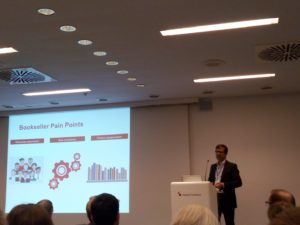As the success of the 2015 edition proved, the EDItEUR’s International Supply Chain Seminar, relaunched last year as a mini-conference one day ahead of the Frankfurt Book Fair, is an occasion to gather inputs about standards and metadata, and to address strategies to use technology in order to extract the most value from the book supply chain.
In the 38th edition of the seminar EDItEUR, the organisation coordinating since 1991 the development of international standards infrastructure for e-commerce in several sectors of the publishing industry, organised a rich panel of presentations and real-world case studies by an international group of expert speakers, from the publishing sector and beyond.
In the opening session, Graham Bell, Executive director of EDItEUR, welcomed the attendees, representing a huge number of countries and all parts of the publishing industry – from publishers to distributors, to booksellers and service providers – and introduced the keynote speaker Ruth Jones, director of business development at Ingram Content Group.
Jones focused her speech on technology and competition, stimulating the audience with some critical questions: how should the publishing industry get going with the pace of change? What does the supply chain look like to support multi-retailer environments? How to react successfully to emerging competition and market shifts – not only to Amazon’s and big players predominance, but also to the complex challenges of the book trade as a whole?
The efficiency of the supply chain is for sure a pivotal element to satisfy market expectations: consumers expect to find the products they want and to have seamless purchasing processes in a friendly environment. The key to reach this goal is building curated and engaging websites and platforms, where the proper use of metadata can tailor the products to the right target – especially when describing digital products that require more specific information about content consumption, such as content structure, ways of delivery, interoperability details etc. In one word, metadata is the opportunity for the curation of customers, through the curation of product information – which is the only path to reach consumers and gain success in the digital supply chain.
The effectiveness of using curated metadata is the key message underlying David Walter’s presentation of “The importance of metadata for discoverability and sales”. Walter, business development director at Nielsen – commerce solution and metadata, presented the updated study by Nielsen on “The link between metadata and sales”, originally published in 2011-2012. The original study has been brought up to date with new data and a new look at how the value of metadata has changed over five years.
The assumption that the lack of the appropriate data needed for consumers and booksellers to discover and trade titles will have a negative impact on sales has been confirmed by the key findings of the study, highlighting two main reasons why metadata mitigate the complexity of the supply chain. First, tradeability: the data describing a book record helps it move smoothly along the supply chain, e.g. supporting booksellers in planning their stock, managing orders and warehouse. Second, product discoverability benefits from curated metadata both for booksellers, who can timely meet customer needs, and for readers, who can find what they are looking for.
The report consists of a UK metadata study and a US metadata study that will be published in late Autumn 2016, both focussing on 100,000 best-selling print titles over a 12 month period. Looking more in depth into the results, we see that the more the trade market relies on digital communication of publishing information, the more rich and accurate metadata can help the timely and successful delivery of products to consumers, e.g. through timeliness in metadata communication, rich descriptive fields, provision of cover image, compliance to ONIX for Books metadata standard. The results of Nielsen analysis strengthen the positive correlation between metadata and higher sales (but also higher library borrowings!) already emerged in the previous version of the survey, and give evidence through an authoritative research to issues that publishing professionals should be well aware of since the beginning of their activities in the book supply chain.
If the importance of the use of metadata is beyond doubt, the use of standard metadata formats must be stressed as another key factor of success for digital information delivery. This has been brought to the audience attention by Susan Scott, from the London School of Economics and Political Science, whose presentation “Metadata, standards and publishing: lessons from the financial sector” gave an effective lesson about the importance of speaking the same language within a community of professional users.
Scott provided the perspective of online information exchange from a completely different sector, as far as productive activities, but at a certain level close to publishing, as far as metadata management is concerned. The focus of the speech was on SWIFT (Society for Worldwide Interbank Financial Telecommunication), a standard modelling the communication protocols between financial institutions.
Needless to say that, in order to enable the huge bank community to rapidly and efficiently work at international level, standardised communication processes and metadata formats describing the content of the information are required to enhance the interbank system: that is what SWIFT system provides, ensuring the secure exchange of cross-border financial information by supplying standard messaging formats adopted worldwide by more than 11,000 financial institutions in more than 200 countries. The similarity with the purpose of ONIX set of standard messages for the communication of publishing metadata is clear, especially as for the considerable benefits for the user community produced by the adoption of standards: Susan Scott reported an increase in profitability of 40% particularly for the smallest institutions that, using the same tools as the big corporations, have the chance to be more competitive on the market. Moreover, using SWIFT standards creates a “network effect” generating immediate as well as long-term benefits for the whole bank community, whose members are able to cooperate sharing standard tools while exploiting a strategic asset for competition.
So, which are the insights for the publishing sector? In synthesis, in the same way as SWIFT is an industry standard continuously capable of producing value, so ONIX standards continue to benefit their users when also others adopt them: the more a standard is used, the more efficiently the communication exchanges work and the more profitable the community members’ activities become.
Staying with the linguistic metaphor, the standard language used to communicate publishing data requires the ability of effectively delivering information to recipients as an essential completion of the communication process. In the book supply chain such ability is supported by a centralised collecting point of book and e-book data, which is typically the national Books in Print (BiP). Ronald Schild, managing director of MVB, presented an analysis of “How standards are shaping the book market”: the focus was on the Brazilian market, where standards are becoming more and more relevant tools to improve the effectiveness of book sales. Schild’s market research reveals that the current lack of infrastructure in Brazil generates struggles in data exchange from publishers to retailers (and backwards): each player has to maintain many different data formats, which implies a huge work of ingestion, data quality and validation that is leading to an unsustainable time to market. The criticalities observed show that the current “peer to peer communication” can be replaced by a BiP, a centralized hub distributing information from publishers to retailers and performing quality assurance of data flows: such solution will be provided by MVB to the Brazilian supply chain, that will certainly reduce its issues in book data communication and enhance the book market performances through the use of ONIX as standard language for book data exchange, and Thema as book classification scheme.

Ronald Schild discussing the issues of Brazilian market
A further maximisation in the use of bibliographic information is provided by Schema.org, that Graham Bell illustrated as an extra mark-up language used as a form of SEO applied to the semantic content of HTML pages. “Navigating ONIX and Schema.org” with Graham Bell meant understanding the use cases for the combination of Schema.org with the bibliographic information contained in book platforms, identifying the key elements in ONIX for Books that need to be expressed in Schema.org, doing the mapping, finding the gaps between the two languages, and communicating the results to the publishing community. This is what the BISG working group has been doing in 2015 and 2016, with the purpose of enriching the tag suite of Schema.org with information specifically addressing the description of book products. The result of this work can be exploited at its best in the publishing workflows where the use of ONIX is already in place: the structured management of bibliographic information facilitates the reuse of data for the semantic enrichment of web pages through Schema.org, consequently optimising the results provided by the search engines that are able to interpret the extra mark-up language added to Web pages. A more meaningful view of the information on web pages enhancing content discoverability is basically the added value of using Schema.org, that is probably going to be a strategic asset for book and e-book communication in the semantic Web.

Graham Bell showing a snippet of HTML code tagged with Schema.org
The journey around metadata standards proceeded after the break with Alicia Wise from Elsevier, whose presentation “Riding the Marrakesh Express: all aboard for accessible books” is a call for expanding accessibility to visually impaired readers, an issue not free from challenges that are being addressed by the publishing community.
If on the one hand the Marrakech treaty that introduces copyright exceptions for blind, visually impaired and print disabled readers can help broaden the access to reading (as well as other initiatives lead by the Accessible Books Consortium dedicated to serve people with reading disabilities), on the other hand, said Alicia Wise, the best option would be to promote technologies and industry standards that support born accessible publishing. This applies mostly to e-books, where it must be noted also that accessible e-books are actually more usable e-books for everyone – included sighted readers, by virtue of the accessibility features tapping the technical potential of file formats like EPUB. This has been demonstrated by the Italian non-profit Fondazione LIA, a dedicated service to increase the number of accessible e-books available on the Italian market for blind and visually impaired readers, and to add accessibility information to ONIX for Books product records in order to be integrated in the mainstream e-book metadata flows.
By showing examples of how Elsevier is implementing good practices to inform the readership about the accessibility features of Elsevier’s products, Alicia Wise gave evidence of the engagement for a goal that technological standards like ONIX are already able to achieve: i.e. providing accessibility information in a standard fashion in order to improve the efficiency of the book supply chain, and to support the social mission of broadening access to reading.
As a sort of interlude from theoretical speculations on the use of standards, the real use case of Lithuanian book market has been presented by Aida Dobkevičiūtė, director of the Lithuanian publishers association. Bringing standards for information management in the book supply chain has encountered here several challenges. First, Lithuania is a small but multilingual country, where the issue for market players to understand each other is not trivial; secondly, in the past years the increasing book data has been management by libraries: although their core activity is bibliographic data curation, libraries lack – by their nature – of commercial information; finally, until a few years ago Lithuania couldn’t benefit from a national Books in Print, which has been implemented recently.
The latter, in particular, has been a critical factor for the improvement of Lithuanian book market. Although it has been set up only in recent times, the BiP, featuring the latest releases of ONIX for Books and Thema standards, has been pushing forward the development process of the supply chain: even though book sales dropped because of the economic recession (in the period from 2008 to 2014 there were 28% less new titles published), implementing a common language in the trade channels can help the economic recovery, also in view of the internationalization of Lithuanian book market. Moreover, the use of standards allows small players (publisher, book stores etc.) to play on the same ground as the big publishing groups that hold the hugest market share, thus being competitive and, hopefully, increasing their business.

Aida Dobkevičiūtė presenting Lithuanian book market
Speaking about the equal possibility of trading thanks to technological standards, the update on “Thema in the global market place” delivered by Howard Willows, Senior Manager, data development at Nielsen Book, followed the overview of the standard given at the 37th International Supply Chain Seminar, held at Frankfurt Book Fair 2015.
This year, starting from the benefits of using Thema, Willows stressed that the use of an international standard for subject classification for the global book trade is extremely important to support the international business. After many legacy schemes, Thema is now the common language for trading partners who can avoid intricate mappings and cross-mappings from local schemes, that lead to degrade of data, loss of precision and ultimately to loss of sales. And all the actors of the supply chain can benefit from Thema, from publishers to retailers, aggregators and distributors, and – of course – customers.
The second focus was on Thema structure, based on the BIC subject classification. With around 2500 subject categories and 2000 qualifiers organised in a hierarchical structure, Thema also allows to provide market-specific details thanks to 700 national extensions that enable the standard to “look local and act global”.
Such descriptive potential is constantly enriched, and has reached version 1.2 in May 2016. Case studies of the application of Thema have been highlighted in the third part of the speech: Thema is already the primary scheme in Norway, Sweden, Denmark and Germany[1], while implementation is underway in Greece, China and Ireland. Anglo-Saxon countries are promoting and increasingly adopting the scheme, that is also available in a number of languages (Lithuanian among others).
The fourth step is…just to implement Thema! The process can be facilitated through the use of tools available on EDItEUR website and through discussion with national trade associations, standards bodies and all sectors of the supply chain in order to raise awareness in the local book industry.
From standards for metadata management to standards for content management, Bill Kasdorf, VP and principal consultant of Apex Content Solutions, talked about the “Evolution of EPUB: what’s new and what’s on the horizon”. Starting from some acquired assumptions that EPUB is the global “master format” for virtually all systems and for the interchange of accessible content, that it is the base for several educational platforms and can be used for all kinds of publications, it must be noted that its evolution is leading to important developments for the publishing industry. Just to mention some improvements, linked bibliographic metadata will have priority on metadata embedded in EPUB file, in order to make it easier to manage updates, and separate specifications devoted to accessibility and guidelines to enable certification and discovery of accessibility features in an EPUB files will be issued.
In the meanwhile, the Digital Publishing Interest Group is working to improve the Open Web Platform for publishing and to create the PWP (Portable Web Publication), that is one single publication for both online and offline consumption with a single URL leading to both versions. The combination of IDPF and W3C recently approved will facilitate this process, ensuring the participation of the publishing industry to a development plan that is probably going to change radically the approach to digital reading.
In the closing of the event, Tim Devenport, Executive Director of the ISNI international agency, illustrated how the “ISNI – A Question of Identity” is used and applied in the content industry. The International Standard Name Identifier is an ISO standard code identifying the public “personas” of persons or organizational units. Its primary goal is to solve problems of name ambiguity in search and discovery, thus attributing published works accurately. Its cross-domain nature (it applies to identities of all kinds: writers, actors, music composers etc.) allows ISNI to be a critical component for Linked Data application, where a persistent bridge is needed to keep track of related resources.
Among its possible uses, ISNI can be exploited to identify rightsholders, protect rights and their management, assist in royalty collection, clarify questions of attribution, disambiguate related identities. With more than 9 millions of ISNIs assigned, 33 member organisations, 11 Registration Agencies in 18 countries, ISNI adoption is going to increase along with the combination of standard identifiers with other metadata standards like ONIX: e.g. adding the ISNI code to an ONIX book product record allows to unambiguously identify the authors and the parties involved in the book production, thus enhancing the robustness of book data flows.
After a fruitful day of discussion around metadata and content standards for book and e-book publishing, participants gained an in-depth view of several critical points that must be taken into account in order to boost the effectiveness of publishing activities. The core lesson, extensively illustrated by the panel of speakers, was that the use of metadata standards is not only the backbone of the electronic communication of publishing information, but also a huge opportunity to gain visibility, discoverability of content and increase the profitability of the book business.
[1] For a successful example of the application of the standard in a big market, see Ronald Schild’s presentation at the 37th International Supply Chain Seminar, summarized here [LINK http://www.smartbook-tisp.eu/resources/the-37th-international-supply-chain-seminar-standards-and-technologies-for-the-book-industry].
 By
By 

















